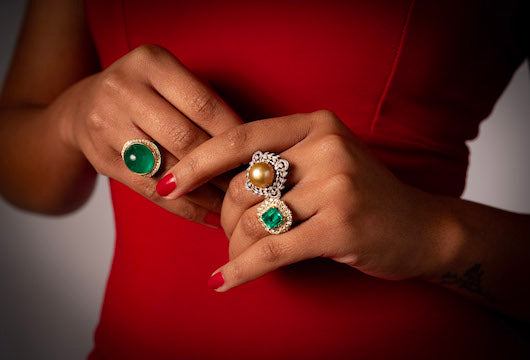Jade - The Stone of Heaven
As the world’s most expensive gemstone, fine jade outpaces even diamonds in the price it commands carat for carat. Coveted by cultures around the world for thousands of years, it is only recently that the western world has come to fully recognize the merits of this luminous gem. Interestingly, jade’s historical importance belies the multiplicity of its nature.
Jade has three distinctive yet intertwined histories, because jade is not one stone, but three – jadeite, nephrite, and the recently recognized omphacite. Strikingly similar in appearance and use, this peculiarity wasn’t formally recognized until the 1800’s because each mirrors the attributes of the other so closely. All are recognized in gemstone nomenclature as jade, but each exhibits important mineralogical attributes which set it apart from the other.
Jadeite is a sodium aluminate silicate, while nephrite is a calcium magnesium iron silicate. Jadeite is also harder at 6.5-7 on the Mohs scale (nephrite is 6 -6.5), while nephrite is the tougher of the two, with crystals that interlock in a dense fibrous mat more resistant to fracturing. Their specific gravities and refractive indexes also show subtle differences that can help specialists differentiate between them, but for the average individual the materials are strikingly similar.
It is also important to recognize that their differences extend beyond their mineralogical composition, as each also has its own unique uses and presence in the historic record.
Nephrite
Nephrite is inarguably the longest utilized of the two. Its presence has been documented in prehistoric sites, Maori archaeological finds, and ancient royal Chinese burials. Maybe because of its green, earthy color, nephrite was frequently associated with ties between the heavens and the earth, although it exists in a variety of colors, including black, white, and blue.
Beads made of the material have been found placed in the mouths of the dead at prehistoric burial sites, which clearly indicates the reverence with which the material was held. In China, emperors were buried in entire body suits of nephrite, and artists carved breathtaking works of art from its malleable material. The Maori of New Zealand used nephrite to create deadly weapons, as the implements held a wicked edge for ancient warriors. Not limited to beautiful objects for ceremonial display, nephrite weapon heads like the “mere”, were used to strike opponents in the body and head. The symbolic relationships between this gemstone and humanity have persisted into modern times among native societies throughout New Zealand and Asia.
Jadeite
Jadeite, on the other hand, arrived in China only in the late 1700s, but was utilized in the New World for much longer by the Maya and the Aztecs. Mesoamericans believed the stone could cure a host of ailments and utilized it in healing rituals for millennia. In fact, the name “jade” comes from the Spanish phrase Piedra de ijada, which translates to “stone of the pain in the side.”
Early Spanish explorers coined the name when they saw indigenous groups clasping pieces of the dense material against their sides to cure maladies of the kidneys. Jadeite occurs only in metamorphic rocks, and its presence at the earth’s surface is rare, indicating great turmoil and upheaval in the soil in which it is found. Its most important source is a large deposit near Tawmaw, Myanmar (Burma), but it has also been found in Guatemala, Japan, Kazakhstan, Russia, and in small pockets in California. Jadeite’s hardness surpasses even nephrite, but it is the unique transparency and luster that fine pieces hold which made it so popular upon its arrival in China.
Jadeite can be found in an array of colors, including shades of lavender, green, gray, white, and black, but it is the brilliant, vivid green “imperial Jade” that is most treasured. Highly prized by Chinese royalty, this shade was reserved for use by the royal family exclusively at one time. Its stunning color and high level of translucence have made it the most expensive gem in the world in its best representations.
Omphacite
Omphacite jade was first discovered in Bavaria, Germany in the early 19th century. The name comes from the Greek word for 'unripe grape', a nod to its green color. According to GIA, the chemical composition of omphacite lies between that of sodium-rich jadeite and calcium-rich augite. Omphacite is visually and gemologically similar to jadeite. Similar to the confusion surrounding jadeite and nephrite, many jade pieces thought to be jadeite were actually later discovered to be made of omphacite.
Jade's Importance to Chinese Culture
In modern China, gifts made from jade are given at almost every important milestone, to include birthdays, anniversaries, marriages, and other celebrations. It is also a commonly used material for producing religious art.
Today, China remains the country where the importance of jade is the highest. As China's middle class continues to grow, the demand for jadeite has exploded on the world market. Some estimates say that more jadeite has been mined sold in the past 50 years than in the entire history of the stone, and with recent sale prices reaching upwards of $27,000,000 for important pieces, one can only speculate on where prices will go for the Stone of Heaven as supplies diminish.


